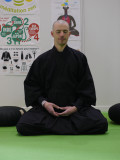Meditation for beginners: techniques and tips to find calm in a hectic world
What follows is a personal guide and tips to meditation for beginners by someone (me) who has been meditating for almost 15 years.
So maybe your are feeling a lot of stress, anger, sadness, confusion or something intense and bad that just won't go away. You are seeking peace and stillness, and maybe a little clarity. Meditation certainly offers the benefits you are seeking and maybe more: studies show that meditation offers real physical benefits. I like to think that it also lets you give back to the world.
Why listen to me? I am not an expert or guru or Zen master or anything. I have tried different types of meditation over the last 15 years. I can say honestly that meditation has helped me and my life immensely--it is maybe the one thing that wasn't a person that helped me the most.
What follows is a short guide that is no means comprehensive, but is sincere and based on personal experience (read: trial and error). I want to help you get a start on your own meditation practice.
Below, I cover 5 different topics on meditation: (1) what is meditation? (2) basic techniques (3) alternative forms of meditation; (4) the benefits of meditation practice; and (5) some final advice or tips.
(1) What is meditation? For beginners, what is a good summary of it?
What is meditation? It is a practice in which we use physical techniques to calm the breath and calm the body. This physical stillness will help us, in the short run and over time, learn to calm our minds. With a still mind, we will be able to see our lives clearly, and with this clarity, feel more at peace with ourselves. With that peace, I think, we can learn better to help ourselves and to help others.
As you will see, many things could be covered by meditation practice: anything that helps your focus and find some mental stillness and calm might be a type of meditation practice.
(2) Basic meditation techniques
Most types of formal meditation involve a seated posture (still body), a breathing technique (still breath), and a focus (still mind).
Sitting posture. Keeping the body still is like laying the foundation for meditation. What is important, basically, is that you sit upright with reasonable comfort (there will be a little bit of discomfort if you sit for long periods, but it's important that you not be in constant pain as you sit).
How do you sit upright and still? Ideally, your knees and behind are on the ground--this is the most stable position (it's like a tripod). But do what you can.
The famous lotus position or half-lotus position (the one that I use) is usually the best for this. It is also best if you are sitting for longer periods to have a cushion underneath your rear-end as support (your back will kill you if you just sit flat on the floor). This video is helpful:
If you are flexible enough, do the lotus position. If you're kind of flexible, do the half lotus (I do). You can also sit samurai style, sitting with your shins parallel to each other on the ground and sitting with your rear end right on the bottoms of your feet--if that doesn't hurt too much (I tried it and stopped because I found I could not sit long periods like this).
Can't sit in any of these ways? No problem! You can always meditate by sitting in a chair, or sitting with the wall for support (like Adam Yauch, or Ad Rock from the Beastie Boys--that may be a bit dated for you kids out there...) . There are even specialized meditation chairs.
One or two more points on sitting posture: However you sit, sit up straight, like your head and body are dangling from a string coming right out of the top of your head.
With your hands, you can do many things. In the Buddhist tradition, you create a mudra, holding your hands in a circle just under your belly button. You can also make rings with your index fingers and thumbs, or put your hands in a prayer position. Find out what works for you.
Finally, keep your eyes half closed, and stare on the floor about 3 feet in front of you. Keep your focus on that spot on the floor. Don't close your eyes completely because you might fall asleep, which is nice, but is not really meditation.
The breath. The breath is your anchor. As you sit, breath in for three long seconds (i.e., counting "one-one thousand, two-one-thousand" seconds), and breath out for seven seconds. This doesn't have to be exact, but close. As you meditate, always come back to the breath--in and out, in and out. Breathe in through your nose and keep your mouth closed. Keep your tongue on the roof of your mouth.
The focus or intention. This is where there is the most variation amongst traditions, and what may take more trial and error to see what works for you. Your focus or intention is what you are doing with your mind while your body is still and your breath is coming in and out.
Common to all these techniques is that you have something to come back to. A lot of our mental pain or confusion--which also becomes physical pain--is the swirl of endless thoughts and emotions that obsess us, and that we endless engage with, analyzing, mulling, planning thinking.
The focus or intention helps us cut through this mess, at least while we are formally meditating.
We don't meditate to think through rational problems or replay events or continue to fume about being cut off in traffic--though that will happen despite ourselves.
On the flip side, the point is not to eradicate all thinking or emotion (I used to think this was the point of meditating; I do not think so now). It is to really to hang back and just observe, to see, to investigate. --not think more, not to hang on to thoughts we like or avoid thoughts we don't like--but just to see what is there, to watch thoughts and emotions and images come and go.
Anyway, here are some common techniques that help you "cut through" your thinking:
- Count from one to ten. Breath in, breath out one. Breath in, breathe out, two. Keep your focus clear. If thoughts appear in your mind and you become distracted, then start over at one. Repeat. Once you get to 10, start at one again. I started with this technique and found it very helpful.
- "What am I? Don't know." This is the focus of the Korean Zen tradition. While breathing in, you ask yourself, "What am I?" As you breath out, you answer "Don't know." What is effective about this technique (it is the one that I use now) is that the question is the fundamental one.
- Just sitting. In the Japanese Zen Soto tradition, this is called shikantaza. You have your proper sitting posture and breathing technique, and you just . . . sit! Really, you just focus on your breath and become aware of your surroundings. I would not recommend this as your very first focus/intention (in the Soto tradition, it is considered quite advanced, I have read--but don't worry about it), because it is quite unstructured. But to just sit is a wonderful thing. Try it sometime, after you've tried the other techniques a bit.
- Contemplating a koan. A koan is a riddle that is not meant to be figured out logically or rationally, but rather is meant to cut through ordinary conceptual thinking. A common example cited is: "What is the sound of one hand clapping?" or "Does the dog have Buddha nature?" This is a helpful and important practice in the various Zen traditions. I would not recommend this sort of practice without finding a formal teacher. Most writings on koans, I have found, are too confusing--and in fact the point of koans is to get beyond mere words. So I won't try to confuse you here...
- Repeating a mantra silently. In some traditions, you repeat a mantra such as "Om" or some other word. You focus on this word and come back to it whenever you find yourself lost or distracted by your thoughts and feelings.
(3) Alternate forms of meditation
While I've described formal meditation above, actually, anything is meditation if you do it with the same intention or focus. Here are some examples.
- Chanting or praying aloud. In yoga, you chant "Om," or . In the catholic tradition, you do Hail Marys. In the Tibetan tradition, monks chant Buddhist liturgies. All of this, I think, has the same effect (by way of a different technique) of helping to clear the mind of distractions--to allow us to loosen somewhat the hold that our thoughts and emotions have on us by actively doing something.
- Walking. Walk purposefully and consciously, with each step. At long meditation retreats, walking meditation usually follows a 30 to 40 minute session of sitting meditation, to get some blood circulating in the legs and to prevent sleepiness. But the walking itself is also meditation.
- Other physical activity. In the Islamic sufi tradition, mystics--who apparently believed in a form of Islam that depended less on books or imams and more on having a silent relationship with the Creator, simply spun and stood in place (the famous "Whirling Dervishes"). What I think (and I cannot speak for them because I don't know that much about sufism) this whirling did was to boils away thoughts and feelings, or make it harder to obsess or latch on to them. There is a wonderful scene in the movie "Monsieur Ibrahim" (one of Omar Sharif's more recent films, in French) showing the sufis standing and slowly spinning in place.
- Yoga. Yoga was originally a warm-up to meditation, but it is a wonderful practice in itself. I also practice yoga (sometimes). But the yoga itself, with its focus on connecting breathing and postures, is helpful. Most people who do yoga describe a calm sensation that they don't get even after a great workout running or spinning.
(4) Benefits of meditation
There are actual, tangible benefits to meditation. Many studies have shown that regular, daily meditation, for longer periods, helps decrease your heart rate and blood pressure, and increase the oxygen supply in your blood stream. It has also been known to help improve your immune system, and to improve mood and general happiness.
In my experience, these physical benefits are real. I have noticed some other mental benefits--I seem to be able to work better, with more focus and less fatigue right after meditating. I also generally feel a bit clearer emotionally--i.e., I can see a bit more clearly why I feel the way I do about certain things. And while things still bug me, very often, these feelings disappear more quickly than they used to.
But, perhaps most important, these benefits are shared with other people and things. I've watched people meditate over the years who were quite difficult but became noticeably sweeter, more helpful, or generally less obnoxious than they were before starting a meditation practice.
A quick story: I remember a guy from my freshman year in college who was just . . . nuts. I mean, he was quite a strange person and not easy to get along with. He talked a lot and told strange stories, largely about himself. I started my senior year going to an on campus meditation group, and when I saw he was in it, I rolled my eyes. But after talking with him after one group session, I noticed that he was different--he listened to people and was quite pleasant to be around. He was the same person, but like a nicer version of the nutso kid I met as a freshman. Something about his change really struck me and helped motivate me to stick with meditation practice.(5) Several final thoughts on meditation
I have a couple of thoughts I thought i would leave with--from one beginner to another.
First, just get started! Read whatever you get your hands on (I did), but read enough to learn the basic techniques and give it a try. It is more important to get the actual physical and mental experience of meditating than it is to just read about it. If you're not doing something right, you can adjust, or if you meditate with a group (see below), you can discuss it and adjust accordingly. But whatever you do, learn the basics and get started!
It's like a manual to your car: you can all about how it works, but reading the manual won't get you to the grocery store or to soccer practice.
(Still, I recommend a couple of books below. Read them, find others that suit you, but then, just do it!).
Second, seek out a meditation group--any group that you feel comfortable with, of whatever denomination or religion you are comfortable with, that will support you. Mostly, people think of meditation as an eastern religious practice associated with Buddhism (Zen or Tibetan) or Hinduism (yogi, etc.), but it exists in the Judeo-Christian and Islamic traditions as well (gnostics and sufis). You don't have to stray too far from whatever religious tradition you grew up with (if that makes you uncomfortable) to find some type of meditation. The Korean Zen tradition that I follow has had many Christian-Buddhist retreats and the like, and I think these interchanges were enriching to all who participated.
Third, try to commit to meditating every day that you can. I know that you're busy, as are we all, but the real benefits of meditation come from daily practice. So start with whatever you can make time for--5 minutes and 10 minutes, and stick to it. Work your way up over time, but
Lastly, and kind of repeating myself, while this is post about meditation for beginners, remember: You are always a beginner! Maybe that sounds frustrating, but to me, it is one of the wonderful things about meditation--this practice always brings you back to the basics.
In my opinion, a good meditation practice is the one that maintains what is called "beginners mind"--this curiosity and openness to learn and find out what is going on, as opposed to assuming that you already know it all (and unless you're paying close attention, you may not even know that you are assuming you know it all).
Look at this way: You already have a beginner's mind, which is wonderful! You already have everything you need for your meditation practice. Keep that mind, that open and seeking mind, to, as the Buddha put it, investigate this life closely. Or as Johnny Cash might have put it, to keep a close watch on this mind of yours.
Some book recommendations on meditation for beginners (but please don't just read--start meditating!)






